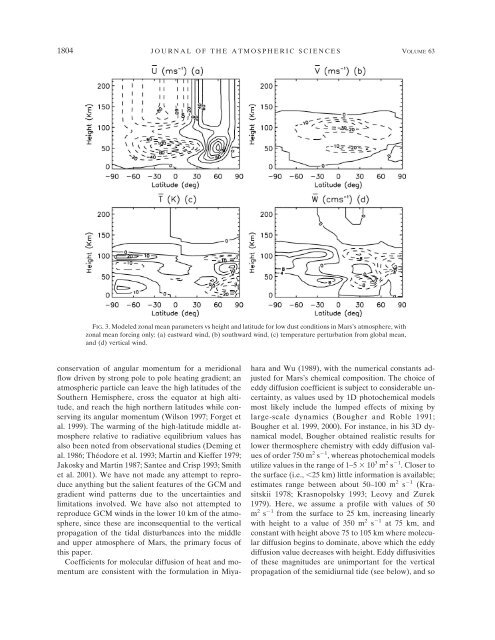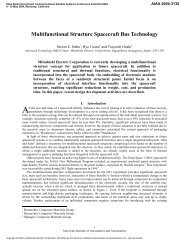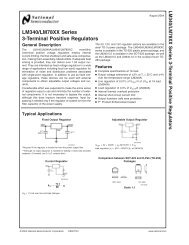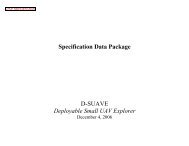JULY 2006 FORBES AND MIYAHARA 1803high-dust conditions ( 5.0). The diurnal heat<strong>in</strong>g pr<strong>of</strong>ilefor 2.3 is also provided, and we assume <strong>the</strong>semidiurnal pr<strong>of</strong>ile to have <strong>the</strong> same shape and <strong>the</strong>same maximum value relative to <strong>the</strong> diurnal componentas 5.0. Zurek (1986) also provides <strong>the</strong> noontimeequatorial dusty 0.67J(III) pr<strong>of</strong>ile from <strong>the</strong> Leovy andZurek (1979) study. [In this notation a vertical pr<strong>of</strong>ile<strong>of</strong> heat<strong>in</strong>g per unit mass (J) is denoted s J(I, II, III),where s is <strong>the</strong> fraction <strong>of</strong> solar radiation absorbed bydust <strong>in</strong> <strong>the</strong> atmosphere, I denotes a low-dust verticalpr<strong>of</strong>ile shape that ma<strong>in</strong>ly simulates surface heat<strong>in</strong>g, andII and III are two different vertical pr<strong>of</strong>ile shapes thatsimulate <strong>the</strong> effects <strong>of</strong> atmospheric heat<strong>in</strong>g by airbornedust]. This provides an unambiguous means to calibrate<strong>the</strong> low-dust pr<strong>of</strong>ile, designated 0.10J(I) <strong>in</strong> Leovy andZurek (1979). Compar<strong>in</strong>g Fig. 1 <strong>of</strong> Zurek (1986) withFig. 10 <strong>of</strong> Leovy and Zurek (1979), a peak heat<strong>in</strong>g rate<strong>of</strong> 3.2 W kg 1 for 0.67J(III) implies a peak diurnalequatorial noontime heat<strong>in</strong>g rate (at <strong>the</strong> ground) <strong>of</strong>1.34 W kg 1 for 0.1J(I). The relative amplitude <strong>of</strong> <strong>the</strong>semidiurnal heat<strong>in</strong>g for this low-dust case is given <strong>in</strong>Leovy and Zurek (1979), and we note that <strong>the</strong> correctsign <strong>in</strong> <strong>the</strong> exponential expression for J(I) as noted byZurek (1986) is used here.c. Zonal mean heat<strong>in</strong>g rates and backgroundatmosphereAlthough our emphasis <strong>in</strong> this paper is on <strong>the</strong> solarsemidiurnal tide, it is necessary to <strong>in</strong>troduce dissipativeprocesses and a zonal mean w<strong>in</strong>d distribution <strong>in</strong> orderto provide some realism to <strong>the</strong> propagation conditionsencountered by <strong>the</strong> tide. Given <strong>the</strong> virtual absence <strong>of</strong>direct w<strong>in</strong>d observations <strong>in</strong> <strong>Mars</strong>’s atmosphere, weadopt a simplistic approach guided by exist<strong>in</strong>g <strong>Mars</strong>general circulation models (GCMs) that have had somesuccess <strong>in</strong> captur<strong>in</strong>g <strong>the</strong> salient features <strong>of</strong> o<strong>the</strong>r observables<strong>in</strong> <strong>Mars</strong>’s atmosphere, and on gradient w<strong>in</strong>ds below60 km determ<strong>in</strong>ed from temperatures measured by<strong>the</strong> Thermal Emission Spectrometer (TES) <strong>in</strong>strumenton <strong>Mars</strong> Global Surveyor (Smith et al. 2001). Towardthis end, we <strong>in</strong>troduce zonal mean <strong>the</strong>rmal forc<strong>in</strong>g <strong>in</strong><strong>the</strong> model that is antisymmetric about <strong>the</strong> equator witha cos dependence ( colatitude), consistent withSou<strong>the</strong>rn Hemisphere summer conditions. The verticaldistributions <strong>of</strong> heat<strong>in</strong>g are Gaussian-shaped functionswhose peak altitudes and amplitudes are chosen so that<strong>the</strong> zonal mean w<strong>in</strong>d and temperature distributionssimulated by recent GCMs for <strong>the</strong> middle atmosphere(Forget et al. 1999) and <strong>the</strong>rmosphere (Bougher et al.2000) are approximated (see below). For <strong>the</strong> radiativecool<strong>in</strong>g we utilize <strong>the</strong> same Newtonian cool<strong>in</strong>g parameterizationdetailed <strong>in</strong> Forbes et al. (2002). Aboveabout 80 km, <strong>in</strong> <strong>the</strong> non-LTE region,(where LTE stands for local <strong>the</strong>rmodynamic equilibrium)this is based on exact 15-m cool<strong>in</strong>g calculationsover a range <strong>of</strong> reference temperatures and pressures,which are <strong>the</strong>n used to choose an average pr<strong>of</strong>ile that isrepresentative <strong>of</strong> <strong>the</strong> range <strong>of</strong> temperature deviationsfrom <strong>the</strong> mean reflected <strong>in</strong> <strong>the</strong> calculations. At loweraltitudes, <strong>the</strong> rates closely approximate those illustrated<strong>in</strong> Barnes (1984, 1990) that are based on <strong>the</strong> detailedradiative calculations <strong>of</strong> Barnes (1983). The two cool<strong>in</strong>gpr<strong>of</strong>iles are merged toge<strong>the</strong>r <strong>in</strong> <strong>the</strong> 70–80-km heightregion.The zonal-mean zonal, meridional, and vertical w<strong>in</strong>dsand perturbation temperatures due to <strong>the</strong> heat<strong>in</strong>g ratesspecified above are illustrated <strong>in</strong> Fig. 3, for low-dustconditions. The ma<strong>in</strong> features <strong>of</strong> <strong>the</strong> zonal w<strong>in</strong>ds depicted<strong>in</strong> dynamical models <strong>of</strong> <strong>Mars</strong>’s atmosphere(Théodore et al. 1993; Coll<strong>in</strong>s et al. 1997; Forget et al.1999; Joshi et al. 1995; Bougher et al. 2000) are exhibitedhere. Zonal mean eastward (w<strong>in</strong>ter) and westward(summer) jets <strong>of</strong> order 60–80 m s 1 <strong>in</strong> <strong>the</strong> <strong>the</strong>rmosphere,and 100–120 m s 1 for <strong>the</strong> correspond<strong>in</strong>g jets<strong>in</strong> <strong>the</strong> middle atmosphere, with some degree <strong>of</strong> closure<strong>of</strong> <strong>the</strong> middle-atmosphere jets above 70 km. The latterfeature is caused by resolved-scale wave drag and tosome extent parameterizations <strong>in</strong>troduced <strong>in</strong>to <strong>the</strong>semodels to account for subgrid-scale wave stresses.Given our <strong>in</strong>ability to simulate <strong>the</strong> resolvable wavestresses accounted for <strong>in</strong> <strong>the</strong> GCMs, and <strong>the</strong> ad hocnature <strong>of</strong> <strong>the</strong> gravity wave parameterizations, <strong>the</strong> sameeffect is accomplished here through <strong>in</strong>troduction <strong>of</strong> aRayleigh friction distribution peak<strong>in</strong>g at 5.0 sol 1 near80 km, <strong>the</strong> estimated break<strong>in</strong>g height for topographicgravity waves <strong>in</strong> <strong>Mars</strong>’s atmosphere (Joshi et al. 1995).The middle-atmosphere westward jet is very similar <strong>in</strong>magnitude and latitud<strong>in</strong>al extent compared to <strong>the</strong> gradientw<strong>in</strong>ds estimated from MGS/TES temperatures(Smith et al. 2001), but <strong>the</strong> eastward middleatmospherejet maximum (120 m s 1 )is40ms 1 lessthan that <strong>of</strong> Smith et al. (2001). Intrusion <strong>of</strong> <strong>the</strong> westwardjet <strong>in</strong>to <strong>the</strong> Nor<strong>the</strong>rn Hemisphere, and <strong>the</strong> highlatitudelocation and <strong>in</strong>tensification <strong>of</strong> <strong>the</strong> eastward jet<strong>in</strong> <strong>the</strong> Nor<strong>the</strong>rn Hemisphere are also features exhibited<strong>in</strong> <strong>Mars</strong> middle-atmosphere models and gradient w<strong>in</strong>ds.The zonal mean temperature perturbations correspond<strong>in</strong>gto <strong>the</strong>se calculations are similarly consistent<strong>in</strong> broad features with those <strong>of</strong> <strong>the</strong> cited GCM resultsand with observations. For <strong>in</strong>stance, <strong>the</strong> 20-K warm<strong>in</strong>gat 60–80 km <strong>in</strong> <strong>the</strong> high-latitude w<strong>in</strong>ter hemisphereis due to subsidence heat<strong>in</strong>g by <strong>the</strong> descend<strong>in</strong>g branch<strong>of</strong> a global Hadley cell (refer to Fig. 3) whose polewardmotion is accelerated by Coriolis and centrifugal forcesdue to <strong>the</strong> westward mean w<strong>in</strong>ds <strong>in</strong>trud<strong>in</strong>g <strong>in</strong>to <strong>the</strong>Nor<strong>the</strong>rn Hemisphere. The latter feature results from
1804 JOURNAL OF THE ATMOSPHERIC SCIENCES VOLUME 63FIG. 3. Modeled zonal mean parameters vs height and latitude for low dust conditions <strong>in</strong> <strong>Mars</strong>’s atmosphere, withzonal mean forc<strong>in</strong>g only: (a) eastward w<strong>in</strong>d, (b) southward w<strong>in</strong>d, (c) temperature perturbation from global mean,and (d) vertical w<strong>in</strong>d.conservation <strong>of</strong> angular momentum for a meridionalflow driven by strong pole to pole heat<strong>in</strong>g gradient; anatmospheric particle can leave <strong>the</strong> high latitudes <strong>of</strong> <strong>the</strong>Sou<strong>the</strong>rn Hemisphere, cross <strong>the</strong> equator at high altitude,and reach <strong>the</strong> high nor<strong>the</strong>rn latitudes while conserv<strong>in</strong>gits angular momentum (Wilson 1997; Forget etal. 1999). The warm<strong>in</strong>g <strong>of</strong> <strong>the</strong> high-latitude middle atmosphererelative to radiative equilibrium values hasalso been noted from observational studies (Dem<strong>in</strong>g etal. 1986; Théodore et al. 1993; Mart<strong>in</strong> and Kieffer 1979;Jakosky and Mart<strong>in</strong> 1987; Santee and Crisp 1993; Smi<strong>the</strong>t al. 2001). We have not made any attempt to reproduceanyth<strong>in</strong>g but <strong>the</strong> salient features <strong>of</strong> <strong>the</strong> GCM andgradient w<strong>in</strong>d patterns due to <strong>the</strong> uncerta<strong>in</strong>ties andlimitations <strong>in</strong>volved. We have also not attempted toreproduce GCM w<strong>in</strong>ds <strong>in</strong> <strong>the</strong> lower 10 km <strong>of</strong> <strong>the</strong> atmosphere,s<strong>in</strong>ce <strong>the</strong>se are <strong>in</strong>consequential to <strong>the</strong> verticalpropagation <strong>of</strong> <strong>the</strong> tidal disturbances <strong>in</strong>to <strong>the</strong> middleand upper atmosphere <strong>of</strong> <strong>Mars</strong>, <strong>the</strong> primary focus <strong>of</strong>this paper.Coefficients for molecular diffusion <strong>of</strong> heat and momentumare consistent with <strong>the</strong> formulation <strong>in</strong> Miyaharaand Wu (1989), with <strong>the</strong> numerical constants adjustedfor <strong>Mars</strong>’s chemical composition. The choice <strong>of</strong>eddy diffusion coefficient is subject to considerable uncerta<strong>in</strong>ty,as values used by 1D photochemical modelsmost likely <strong>in</strong>clude <strong>the</strong> lumped effects <strong>of</strong> mix<strong>in</strong>g bylarge-scale dynamics (Bougher and Roble 1991;Bougher et al. 1999, 2000). For <strong>in</strong>stance, <strong>in</strong> his 3D dynamicalmodel, Bougher obta<strong>in</strong>ed realistic results forlower <strong>the</strong>rmosphere chemistry with eddy diffusion values<strong>of</strong> order 750 m 2 s 1 , whereas photochemical modelsutilize values <strong>in</strong> <strong>the</strong> range <strong>of</strong> 1–5 10 3 m 2 s 1 . Closer to<strong>the</strong> surface (i.e., 25 km) little <strong>in</strong>formation is available;estimates range between about 50–100 m 2 s 1 (Krasitskii1978; Krasnopolsky 1993; Leovy and Zurek1979). Here, we assume a pr<strong>of</strong>ile with values <strong>of</strong> 50m 2 s 1 from <strong>the</strong> surface to 25 km, <strong>in</strong>creas<strong>in</strong>g l<strong>in</strong>earlywith height to a value <strong>of</strong> 350 m 2 s 1 at 75 km, andconstant with height above 75 to 105 km where moleculardiffusion beg<strong>in</strong>s to dom<strong>in</strong>ate, above which <strong>the</strong> eddydiffusion value decreases with height. Eddy diffusivities<strong>of</strong> <strong>the</strong>se magnitudes are unimportant for <strong>the</strong> verticalpropagation <strong>of</strong> <strong>the</strong> semidiurnal tide (see below), and so













